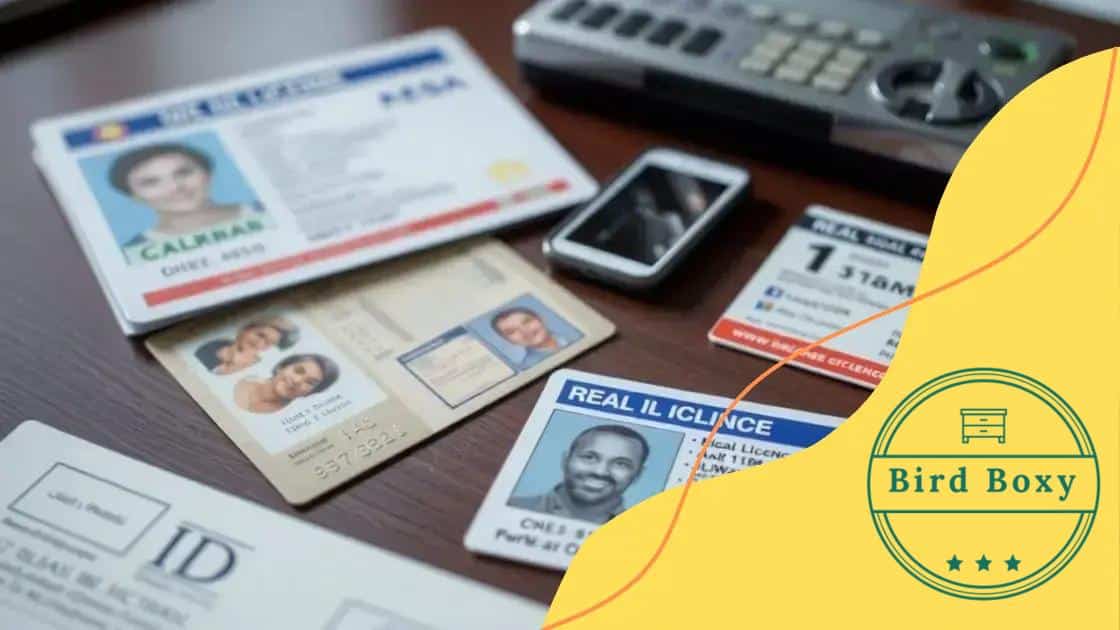Real ID enforcement May 2025: What you need to know

Real ID enforcement begins in May 2025, requiring individuals to obtain a compliant ID for domestic flights and access to federal buildings, using specific documents like proof of identity and residency.
Real ID enforcement May 2025 raises many questions as the deadline approaches. Are you prepared for the new requirements? Let’s dive into what this means for you.
What is Real ID enforcement?
Real ID enforcement is a set of regulations that impacts how we use identification for various services. Effective May 2025, the government will require a Real ID to board domestic flights and enter federal buildings. This change is essential for enhancing security across the nation.
Understanding Real ID
The Real ID Act was passed in 2005 to set minimum security standards for state-issued driver’s licenses and identification cards. It was a response to the 9/11 attacks, aimed at making sure that all states have reliable identification processes.
Key Features of Real ID
- Federal acceptance: IDs must be accepted for federal purposes.
- Verification requirements: Applicants must provide proof of identity, residency, and legal status.
- Enhanced security: The IDs will have improved features to prevent fraud.
Each state is responsible for implementing these regulations. They will need to upgrade their systems to meet the Real ID standards. You’ll notice that some states have begun issuing Real ID compliant licenses already.
If you travel frequently or need access to federal locations, obtaining a Real ID will be crucial. Be sure to check the requirements in your state, as they can differ significantly based on local laws.
Key changes in ID requirements
With the upcoming Real ID enforcement, several significant changes are coming to ID requirements. These updates will impact how individuals obtain and present their identification for travel and access to federal facilities.
What is changing?
The main change involves the need for a Real ID compliant ID for certain activities that were previously permissible with standard IDs. This means that travelers will need to ensure that their forms of identification meet these new criteria.
Key Points to Know
- Starting May 2025, only Real ID compliant IDs will be accepted for boarding domestic flights.
- State-issued IDs need to be upgraded to meet federal standards.
- Other forms of ID, like passports, will still be accepted for air travel.
Many people may not realize that their current IDs might not fulfill the new regulations. It’s essential for everyone to check their identification’s compliance before planning trips. Changes to ID verification also mean enhanced documentation. Most states will require proof of identity, state residency, and legal presence in the U.S. when applying for the new Real ID.
This upgrade is designed to improve security and ensure that identification systems across the country are uniform and reliable. Therefore, it is critical for all citizens to stay informed and take action if they need a new ID.
Who needs a Real ID by May 2025?

As the Real ID enforcement deadline approaches in May 2025, it is crucial to understand who will need a Real ID. This requirement primarily affects anyone who plans to travel by air or enter federal facilities.
Travelers
If you’re traveling within the United States, you will need a Real ID to board domestic flights. This applies to all passengers, including children and those with military IDs. Regular IDs may no longer be accepted after the deadline, so it’s essential to verify your ID status.
Federal Employees and Visitors
Individuals who work for the federal government or need to visit federal buildings must comply with the new regulations. This includes employees of federal agencies, contractors, and anyone attending meetings in federal facilities. Without a Real ID, entry may be denied.
State Requirements
Each state has its own process for issuing Real IDs. If you haven’t obtained one yet, you are encouraged to check with your local Department of Motor Vehicles (DMV) to understand what documents are necessary for applying. Generally, proof of identity, residency, and legal presence is needed.
It’s also important to note that some forms of identification, such as a U.S. passport or military ID, remain valid options for air travel, but residents should still familiarize themselves with the specifics regarding Real ID for future trips.
Consequences of not having a Real ID
Failing to obtain a Real ID by the May 2025 deadline can lead to significant consequences for individuals who rely on identification for travel and access to federal facilities. Understanding these implications is essential for everyone.
Travel Restrictions
Without a Real ID, you will not be able to board domestic flights within the United States. This can create major disruptions for those with travel plans. It’s important to consider alternative options, such as using a passport, but these might not be as convenient.
Access to Federal Facilities
You will also face challenges gaining entry to federal buildings, such as courthouses, military bases, and government offices. Many individuals who need to visit these locations for work or other purposes may find that their standard IDs are no longer accepted.
Additional Impacts
- Increased wait times at the DMV due to a rush of applicants needing a Real ID.
- Potential fines or legal issues for not having proper identification during security checks.
- Inability to complete necessary transactions that require valid ID, such as opening bank accounts or applying for government services.
These consequences not only affect travel plans but can also impact daily activities that require ID verification. Therefore, it is crucial to take action now if you need to obtain a Real ID. Staying informed and prepared will help avoid complications as the deadline approaches.
How to obtain your Real ID easily
Obtaining your Real ID does not have to be a complicated process. With the right preparation and knowledge of the requirements, you can get your Real ID easily. Here are some steps to help guide you through the process.
Know the Requirements
Before heading to your local Department of Motor Vehicles (DMV), it’s important to understand what documents you will need. Typically, you will need to provide:
- Proof of identity, such as a birth certificate or passport.
- Proof of residency, like a utility bill or lease agreement.
- Proof of Social Security number, often found on your Social Security card or tax document.
Gather these documents beforehand to ensure you have everything ready when you apply.
Visit the DMV
Finding your local DMV and making an appointment can save you time. Many DMVs allow you to schedule appointments online. When you arrive, make sure to bring all required documents and any necessary forms completed.
Be Prepared for Fees
Fees for obtaining a Real ID can vary by state, so check your local DMV’s website for specific information. Most states charge a fee that may range from $20 to $50, depending on the ID class and your state’s regulations.
After completing your application, you will receive a temporary ID until your official Real ID arrives in the mail. This process typically takes a few weeks. By following these steps and staying organized, obtaining your Real ID can be a simple and straightforward process, ensuring you are ready for the upcoming deadlines.
FAQ – Frequently Asked Questions about Real ID Enforcement
What is a Real ID and why do I need it?
A Real ID is a government-issued identification that meets federal security standards. You will need it to board domestic flights and enter federal buildings after May 2025.
What documents do I need to obtain a Real ID?
To obtain a Real ID, you typically need proof of identity (like a passport or birth certificate), proof of residency (like a utility bill), and proof of Social Security number.
How much does it cost to get a Real ID?
The cost of obtaining a Real ID varies by state, generally ranging from $20 to $50. Check with your local DMV for specific pricing.
What if I don’t get my Real ID by the deadline?
If you do not have a Real ID by the May 2025 deadline, you will not be allowed to board domestic flights or enter federal buildings with standard IDs.






